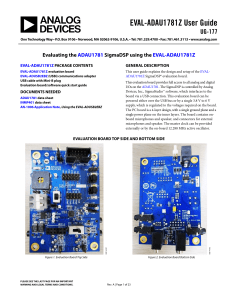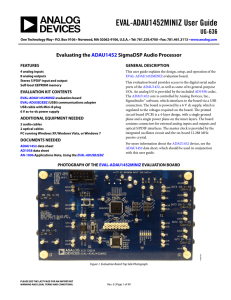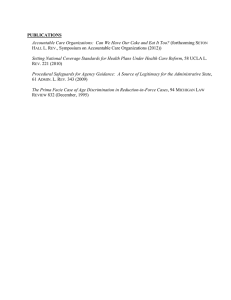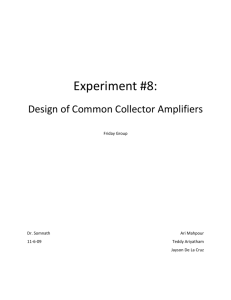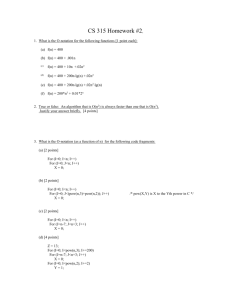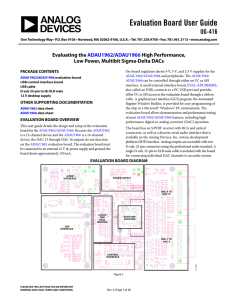Evaluation Board User Guide UG-087
advertisement
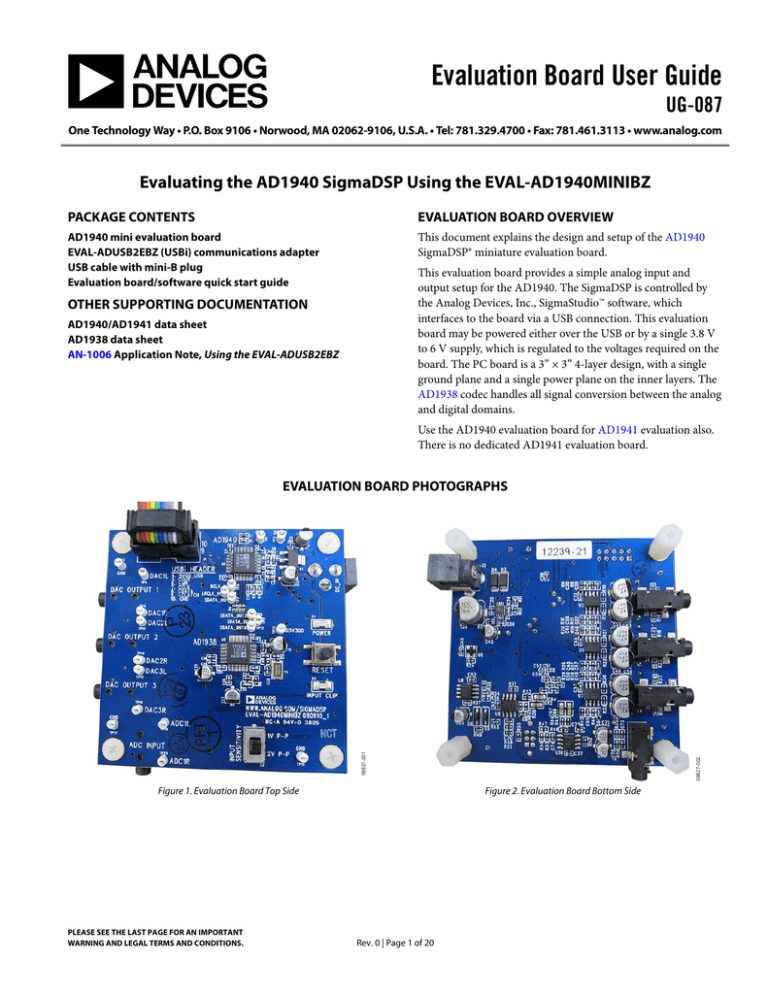
Evaluation Board User Guide UG-087 One Technology Way • P.O. Box 9106 • Norwood, MA 02062-9106, U.S.A. • Tel: 781.329.4700 • Fax: 781.461.3113 • www.analog.com Evaluating the AD1940 SigmaDSP Using the EVAL-AD1940MINIBZ PACKAGE CONTENTS EVALUATION BOARD OVERVIEW AD1940 mini evaluation board EVAL-ADUSB2EBZ (USBi) communications adapter USB cable with mini-B plug Evaluation board/software quick start guide This document explains the design and setup of the AD1940 SigmaDSP® miniature evaluation board. This evaluation board provides a simple analog input and output setup for the AD1940. The SigmaDSP is controlled by the Analog Devices, Inc., SigmaStudio™ software, which interfaces to the board via a USB connection. This evaluation board may be powered either over the USB or by a single 3.8 V to 6 V supply, which is regulated to the voltages required on the board. The PC board is a 3” × 3” 4-layer design, with a single ground plane and a single power plane on the inner layers. The AD1938 codec handles all signal conversion between the analog and digital domains. OTHER SUPPORTING DOCUMENTATION AD1940/AD1941 data sheet AD1938 data sheet AN-1006 Application Note, Using the EVAL-ADUSB2EBZ Use the AD1940 evaluation board for AD1941 evaluation also. There is no dedicated AD1941 evaluation board. Figure 1. Evaluation Board Top Side PLEASE SEE THE LAST PAGE FOR AN IMPORTANT WARNING AND LEGAL TERMS AND CONDITIONS. 08827-002 08827-001 EVALUATION BOARD PHOTOGRAPHS Figure 2. Evaluation Board Bottom Side Rev. 0 | Page 1 of 20 UG-087 Evaluation Board User Guide TABLE OF CONTENTS Package Contents .............................................................................. 1 Setting Up Communications in SigmaStudio ...........................5 Other Supporting Documentation ................................................. 1 Creating a Basic Signal Flow ........................................................6 Evaluation Board Overview ............................................................ 1 Downloading the Program to the DSP.......................................8 Evaluation Board Photographs ....................................................... 1 Using the Evaluation Board .............................................................9 Revision History ............................................................................... 2 Power...............................................................................................9 Functional Block Diagrams ............................................................. 3 Inputs and Outputs .......................................................................9 Board Layout Block Diagrams .................................................... 3 AD1938 Audio Codec...................................................................9 Setting Up the Evaluation Board .................................................... 4 AD1940 SigmaDSP .......................................................................9 Installing the SigmaStudio Software .......................................... 4 Communications Header .............................................................9 Installing the USBi Drivers ......................................................... 4 Reset ................................................................................................9 Configuring the Default Switch and Jumper Settings ............. 5 Evaluation Board Schematics and Artwork ................................ 10 Powering Up the Board ............................................................... 5 Ordering Information .................................................................... 17 Connecting the Audio Cables ..................................................... 5 Bill of Materials ........................................................................... 17 REVISION HISTORY 7/10—Revision 0: Initial Version Rev. 0 | Page 2 of 20 Evaluation Board User Guide UG-087 FUNCTIONAL BLOCK DIAGRAMS ANALOG INPUTS ANALOG OUTPUTS AD1938 CODEC USBi INTERFACE (USB TO SPI) AD1940 08827-003 POWER SUPPLY REGULATION Figure 3. Functional Block Diagram 08827-004 BOARD LAYOUT BLOCK DIAGRAMS 08827-005 Figure 4. Board Layout Block Diagram (Top Side) Figure 5. Board Layout Block Diagram (Bottom Side) Rev. 0 | Page 3 of 20 UG-087 Evaluation Board User Guide SETTING UP THE EVALUATION BOARD 3. INSTALLING THE SigmaStudio SOFTWARE Download the latest version of SigmaStudio online at: http://www.analog.com/sigmastudiodownload. To install, use the following steps: 1. 2. 3. Click Search for the best driver in these locations, then select Include this location in the search. Click Browse to find the SigmaStudio 3.0\USB drivers directory (see Figure 8). Open the downloaded installer file and extract the files to your PC. Install the Microsoft® .net Framework, if not already installed. Install SigmaStudio by double-clicking setup.exe, and following the prompts. INSTALLING THE USBi DRIVERS SigmaStudio must be installed to use the USBi. Once SigmaStudio has been properly installed, connect the USBi to an available USB port with the included USB cable. At this point, Windows® Vista recognizes the device and prompts the user to install drivers. 08827-008 1. 08827-006 Figure 8. Windows Found New Hardware Wizard—Search and Installation Options 4. Figure 6. Found New Hardware Notification 08827-009 Select the Install from a list or specific location (Advanced) option and click Next (see Figure 7). Figure 9. Windows Logo Testing Warning 08827-007 2. When the warning about Windows Logo testing appears on the screen, click Continue Anyway (see Figure 9). Figure 7. Found New Hardware Wizard—Installation The USBi drivers should now be successfully installed. Leave the USBi connected to the PC. Rev. 0 | Page 4 of 20 Evaluation Board User Guide UG-087 If SigmaStudio detects the USBi on the USB port of the computer, the background of the USB label changes to orange (see Figure 12). CONFIGURING THE DEFAULT SWITCH AND JUMPER SETTINGS The board is hardwired in a stereo analog input, six channel analog output configuration that cannot be modified. No jumpers exist on this board, but there is one configuration switch, S2. The setting of S2 determines the input gain of the ADC preamp. The switch can be configured in 1 V p-p or 2 V p-p mode to match the input audio source. 08827-012 POWERING UP THE BOARD To power up the board, connect the USBi’s ribbon cable to the EVAL-AD1940MINIBZ’s communications header, J1. 4. CONNECTING THE AUDIO CABLES Connect a stereo audio source to J6 (ADC input). Connect headphones or powered speakers to J3 (DAC Output 1). The labels for J6 and J3 are only visible on the bottom of the board. Figure 13. Adding an AD1940 SETTING UP COMMUNICATIONS IN SigmaStudio To use the USBi to communicate with the target IC, connect it by dragging a wire between the blue pin of the USB Interface cell and the green pin of the IC. The corresponding drop-down box of the USBi automatically fills with the default mode and channel for that IC. 08827-014 3. 5. 08827-010 2. Start SigmaStudio by double-clicking the shortcut on the desktop. Click File > New Project or press Ctrl+N to create a new project. The default view of the new project is called the Hardware Configuration tab. To use the USBi in conjunction with SigmaStudio, first select it in the Communication Channels subsection of the toolbox on the left side of the Hardware Configuration tab (see Figure 10). Add it to the project space by clicking and dragging it to the right. Figure 10. Adding the USBi Communication Channel If SigmaStudio cannot detect the USBi on the USB port of the computer, then the background of the USB label displays red (see Figure 11). This may happen when the USBi is not connected or when the drivers are incorrectly installed. 08827-011 1. To add an AD1940 to the project, select it from the Processors (ICs / DSPs) list and drag it to the project space (see Figure 13). 08827-013 1. 2. Figure 12. USBi Detected by SigmaStudio Figure 11. USBi Not Detected by SigmaStudio Rev. 0 | Page 5 of 20 Figure 14. Connecting the USBi to an AD940 IC UG-087 Evaluation Board User Guide 3. CREATING A BASIC SIGNAL FLOW To create a basic signal flow, use the following steps: To access the Schematic tab, where a signal processing flow can be created, click the Schematic tab at the top of the screen (see Figure 15). 08827-015 1. Click and drag the input cell into the blank schematic space to the right of the toolbox (see Figure 17). Figure 15. Schematic Tab 08827-017 The left side of the schematic view houses the Tree Toolbox, which contains all of the algorithms that can run in the SigmaDSP. Navigate to the IO > Input folder and select an Input cell. Figure 17. Input Cell 4. In the Tree Toolbox, navigate to the IO > Output folder and select an Output cell (see Figure 18). 08827-016 Figure 16. Input Cell Selection 08827-018 2. Figure 18. Output Cell Selection Rev. 0 | Page 6 of 20 Evaluation Board User Guide Click and drag an output cell to the schematic. Repeat so there will be two outputs (see Figure 19). 8. By default, this cell only has one input channel and one output channel, as indicated by the green input and blue output dots. To add a channel, right click in the blank white part of the cell and select Add Algorithm > IC 1 > Gain (slew) from the menu (see Figure 22). 08827-019 5. UG-087 In the Tree Toolbox, navigate to the Volume Controls > Adjustable Gain > Single/Multiple Controls > Clickless (RC Type) HW Slew folder and select a Single Volume Control cell (see Figure 20). Figure 22. Adding a Channel to the Volume Control The cell should now have two inputs and two outputs (see Figure 23). 08827-020 6. 08827-022 Figure 19. Output Cells Click and drag the Single Volume Control cell to the schematic. Figure 23. Stereo Volume Control Cell 9. Navigate to the Filters > Second Order > Single Precision > 2 Ch folder and select a Medium Size Eq cell (see Figure 24). 08827-021 Figure 21. Volume Control Cell 08827-024 7. 08827-023 Figure 20. Volume Control Cell Selection Figure 24. EQ Cell Selection Rev. 0 | Page 7 of 20 UG-087 Evaluation Board User Guide 13. Configure each filter as required. As an example, Figure 29 shows a low shelf at 50 Hz, peaking filters at 200 Hz, 500 Hz, and 2000 Hz, and a high shelf at 10 kHz. 08827-029 08827-025 10. Click and drag the cell to the schematic (see Figure 25). Figure 25. Single-Band Stereo EQ Cell Figure 29. Configured 5-Band EQ Cell 14. Connect the cells together by left clicking a blue output dot and dragging to the green output dot of the next cell. Continue until the signal flow is completed from input to output for each channel. 08827-026 11. By default, the EQ only has one band. To increase the number of bands, right click in the blank white part of the cell and select Grow Algorithm > 1. 2 Channel – Single Precision > 4 to increase the EQ to 5 bands (see Figure 26). Figure 26. Growing the EQ Cell 08827-031 The EQ should now have five bands (see Figure 27). Figure 30. Completed Signal Flow The basic signal flow is now complete with stereo I/O, a fiveband equalizer, and a clickless volume control (see Figure 30). DOWNLOADING THE PROGRAM TO THE DSP 08827-032 08827-027 To compile and download the code to the DSP, click once on the Link-Compile-Download button in SigmaStudio’s main toolbar (Figure 31). Alternatively, press the F7 key. Figure 27. Five-Band Stereo EQ Cell 08827-028 12. To change the properties of a filter, click once on its corresponding blue filter icon (see Figure 28). Figure 31. Link-Compile-Download Button The signal flow should now be running on the evaluation board, and audio should pass from input to output. The controls for filters and volume can be changed in realtime by clicking and dragging them with the mouse. Figure 28. Filter Properties Button Rev. 0 | Page 8 of 20 Evaluation Board User Guide UG-087 USING THE EVALUATION BOARD POWER AD1940 SigmaDSP Power can be supplied either via the USB bus by connecting the EVAL-ADUSB2EBZ (USBi) to Header J1 or by a tippositive 3.8 V to 6 V dc power supply on Connector J2. The on-board regulator generates the 3.3 V dc supply for the onboard circuitry. LED D1 lights up when power is supplied to the board. The AD1940 receives one I2S stream from the AD1938’s ADCs and sends three I2S streams to the AD1938’s DACs. The registers of the AD1940 and its signal processing flow can be configured in SigmaStudio. COMMUNICATIONS HEADER The communications header, J1, connects to the EVALADUSB2EBZ, also called the USBi. More information about the USBi can be found in the AN-1006 Application Note. INPUTS AND OUTPUTS The board is configured in an analog input-analog output mode. There are two ADC inputs and 6 DAC outputs, each accessible by standard stereo TRS 1/8” mini jacks. The AD1940 uses the SPI communication protocol. The communication port of the AD1938 is not accessible on this evaluation board. The input and output filters are active, and the outputs can drive passive headphones or active speakers. RESET The input sensitivity switch sets the preamp gain, and it can be configured as required for various audio input levels. The two gain settings are 1 V rms and 2 V rms. The input clip LED, D2, lights up when an input signal is close to the full-scale input level of the AD1938. The reset switch, S1, initiates a reset signal, which is generated by the ADM811. This in turn resets the AD1940 and AD1938. A reset event causes the AD1940 to lose its register settings and RAM contents. AD1938 AUDIO CODEC The audio codec operates in standalone I2S mode. Its serial ports are configured in master mode, so the serial ports of the AD1940 should be configured as slaves. The audio codec generates a master clock with its on-board oscillator and the 12.288 MHz crystal resonator, Y1. It sends master clock, frame clock, and bit clock signals to the AD1940. Rev. 0 | Page 9 of 20 Rev. 0 | Page 10 of 20 4 Figure 32. Board Schematics, Page 1—ADC Inputs 0.10uF 4 8 V+ V- 8 C35 ADA4841-2YRZ ADA4841-2YRZ V+ V- U10-C SLEEVE TIP U9-C 5V00_UNREG J6 RING ADC Input 0.10uF C44 ADC1L 100k R50 TP18 R56 100k ADC1R TP20 100pF C73 10uF C71 C75 100pF 10uF C76 + + S2 DPDT Slide R54 1V 2V 5k36 5 2 4 6 3 1 INPUT SENS 5k36 R55 FILTR 5k36 FILTR 5k36 R47 R51 0.10uF C63 0.10uF C19 100kHz Low Pass + - + - 5 6 + - 5k36 5k36 3 2 7 1 7 ADA4841-2YRZ O U10-B R52 R46 ADA4841-2YRZ O U10-A R53 1 ADA4841-2YRZ O U9-A R31 R40 ADA4841-2YRZ O U9-B R48 C74 + - 5k36 270pF 3 2 5k36 5k36 5 6 5k36 270pF C70 237R 237R 237R 237R R43 R44 R33 R39 C66 C67 C60 C62 10uF 10uF 1.0nF C59 1.0nF C58 LEVEL_DETECT_1L 10uF 10uF LEVEL_DETECT_1R 1.0nF C55 100pF C51 1.0nF C56 100pF C52 ADC1LP ADC1LN ADC1RP ADC1RN UG-087 Evaluation Board User Guide EVALUATION BOARD SCHEMATICS AND ARTWORK 08827-033 Evaluation Board User Guide UG-087 270pF DAC1R R16 5k36 R15 3 5k36 2 C38 + ADA4841-2YRZ 1 O - U3-A C33 R12 301R + DAC1R TP8 DAC Output 1 47uF C37 200pF R14 100k RING TIP J3 SLEEVE 270pF R9 DAC1L 5k36 R8 5 5k36 6 C29 5V00_UNREG C30 + ADA4841-2YRZ 7 O U3-B C31 R10 301R + U3-C 5k36 ADA4841-2YRZ R7 100k 270pF DAC2R TP4 47uF 200pF R26 DAC1L C32 0.10uF 8 V+ V- 4 C48 TP14 R25 3 5k36 2 + ADA4841-2YRZ 1 O U5-A C46 R22 301R + DAC2R DAC Output 2 47uF C47 200pF R23 100k RING TIP J4 SLEEVE 270pF R20 DAC2L 5k36 5V00_UNREG C41 TP10 R19 5 5k36 6 + ADA4841-2YRZ 7 O - U5-B C40 C43 R21 301R + 200pF DAC3R 5k36 R41 3 5k36 U5-C ADA4841-2YRZ R18 100k 270pF R42 DAC2L 47uF 2 C68 0.10uF V+ V- 8 4 C65 + ADA4841-2YRZ 1 O - U7-A C61 R35 301R + DAC3R TP16 DAC Output 3 47uF C64 200pF R38 100k RING J5 TIP SLEEVE 270pF 5k36 R28 5 5k36 6 C49 5V00_UNREG C50 + ADA4841-2YRZ 7 O - U7-B C54 R30 301R + DAC3L TP15 U7-C ADA4841-2YRZ 47uF 200pF R27 100k C53 0.10uF V+ V- 8 4 08827-034 DAC3L R29 Figure 33. Board Schematics, Page 2—DAC Outputs Rev. 0 | Page 11 of 20 MCLK 0.10uF 1k00 R1 MCLK 4 PLL_CTRL0 5 PLL_CTRL1 6 PLL_CTRL2 2 3 RSVD 9 NC 14 SDATA_IN0 15 SDATA_IN1 16 SDATA_IN2 17 SDATA_IN3 D3V3DD 1.0nF 0.10uF C5 C2 0.10uF 0.10uF 0.10uF VSENSE = 2.5VDC C4 SDATA_IN0 C6 Q1 10uF 10 LRCLK_IN 11 BCLK_IN TP7 LRCLK_IN BCLK_IN C7 TP5 + U1 1 L1 2 RESETB 23 18 RESET COUT CCLK CLATCH CDATA BCLK_IN R2 19 COUT 20 CCLK 21 CLATCH 22 CDATA ADR_SEL R4 10k0 10k0 C8 0.10uF 100R C28 0.10uF LRCLK_IN R3 29 30 31 32 38 39 41 42 C13 C1 SDATA_IN0 0.10uF 0.10uF 26 LRCLK_OUT0 27 BCLK_OUT0 34 LRCLK_OUT1 35 BCLK_OUT1 SDATA_OUT0 SDATA_OUT1 SDATA_OUT2 SDATA_OUT3 SDATA_OUT4 SDATA_OUT5 SDATA_OUT6 SDATA_OUT7 28 ODVDD 33 ODVDD 40 ODVDD AD1940YSTZ 44 VSUPPLY 47 VREF 46 VDRIVE 45 VSENSE ZX5T953GTA PLL_GND + 1 VDD 13 VDD 25 VDD 37 VDD D3V3DD 1 C9 0.10uF 2 0.10uF TP12 C11 L2 TP11 10uF TP6 43 INVDD 12 GND 24 GND 36 GND 48 GND 8 PLL_VDD RESET CM D3V3DD ADC1LP ADC1LN ADC1RP ADC1RN C14 DSDATA1 DSDATA2 DSDATA3 DSDATA4 DLRCLK DBCLK 10 PD/RST 23 CIN 24 COUT 26 CCLK 27 CLATCH 19 ASDATA2 20 ASDATA1 22 ALRCLK 21 ABCLK 16 15 14 11 18 17 45 ADC2RP 46 ADC2RN 43 ADC2LP 44 ADC2LN 41 ADC1RP 42 ADC1RN 39 ADC1LP 40 ADC1LN U2 0.10uF D3V3DD 13 DGND 12 C10 A3V3DD AD1938 AGND 4 C3 34 C42 AGND DVDD DGND 25 5 AVDD 33 AVDD 37 AVDD AGND 1 48 0.10uF 100R DAC3R 7 R5 DAC3L 6 47 9 MCLK C18 22pF 22pF 390pF C24 12.288MHz C22 DAC2R 31 Y1 DAC2L 8 DAC1R 30 DAC1L 29 28 35 FILTR 38 CM LF OR4 OL4 OR3 OL3 OR2 OL2 OR1 OL1 0.10uF 0.10uF C20 0.10uF C21 C17 C16 2 MCLKI/XI 3 MCLKO/XO AVDD AGND 32 D3V3DD AGND 36 Rev. 0 | Page 12 of 20 7 + C27 CM 0.10uF 10uF C25 5.6nF C26 562R R6 A3V3DD C77 + 0.10uF 10uF C23 FILTR UG-087 Evaluation Board User Guide Figure 34. Board Schematics, Page 3—SigmaDSP and Audio Codec 0 88 27 -0 35 TP9 Rev. 0 | Page 13 of 20 J2 5V00_USB 1 3 2 DC_IN TP2 MBRA140T3G MBRA140T3G LEVEL_DETECT_1R LEVEL_DETECT_1L CM D4 D3 3 2 49k9 + O 1 C36 100uF R45 R49 ADA4841-2YRZ 49k9 + - D5 D6 R37 K K 0.10uF C57 5V00_UNREG A A 49k9 4 C69 10uF U4 ADP3336 1 7 OUT IN 2 8 OUT IN 3 6 OUT SD 5 FB GND + R34 R36 D3V3DD U8-B R11 78k7 R13 C34 4 8 140k 10nF V+ 0.10uF V- C72 U8-C ADA4841-2YRZ 7 O + ADA4841-2YRZ - 5V00_UNREG 5 6 C39 0.10uF D2 A K + TP13 1 L3 POWER R17 475R D3V3DD D1 C12 10uF INPUT CLIP R32 Green Diffused U8-A 2 + C15 10uF A3V3DD TP1 TP19 TP17 TP3 COUT CCLK CLATCH 0.10uF C45 D3V3DD 1 3 5 7 9 2 4 6 8 10 USB_CLK 1 4 U6 MR MR ADM811TARTZ GNDRESET VCC USBi Header SCL SDA J1 HEADER_10WAY_POL 2 3 R24 100k 5V00_USB MR CDATA S1 RESET SPST-NO Evaluation Board User Guide UG-087 Figure 35. Board Schematics, Page 4—Clip Detection, Power Supply, Reset, Communications 0 88 27-0 36 Evaluation Board User Guide 08827-037 UG-087 08827-038 Figure 36. Board Layout, Page 1—Top Assembly Figure 37. Board Layout, Page 2—Top Layout and Screen Rev. 0 | Page 14 of 20 UG-087 08827-039 Evaluation Board User Guide 08827-040 Figure 38. Board Layout, Page 3—Bottom Layout and Screen Figure 39. Board Layout, Page 4—Ground Plane Rev. 0 | Page 15 of 20 Evaluation Board User Guide 08827-041 UG-087 Figure 40. Board Layout, Page 5—Power Plane Rev. 0 | Page 16 of 20 Evaluation Board User Guide UG-087 ORDERING INFORMATION BILL OF MATERIALS Table 1. Qty 29 5 Reference Designator C1, C2, C4, C5, C7 to C11, C13, C14, C16, C17, C19 to C21, C25, C28, C32, C35, C39, C44, C45, C53, C57, C63, C68, C72, C77 C3, C12, C15, C23, C27, C42, C69, C71, C76 C6, C55, C56, C58, C59 2 C18, C22 1 C24 6 C29, C37, C40, C47, C49, C64 1 C26 8 6 C30, C38, C41, C48, C50, C65, C70, C74 C31, C33, C43, C46, C54, C61 1 C34 1 C36 4 C51, C52, C73, C75 4 C60, C62, C66, C67 1 1 2 2 1 1 4 3 1 1 2 1 1 2 9 D1 D2 D3, D4 D5, D6 J1 J2 J3, J4, J5, J6 L1 to L3 Q1 R1 R2, R3 R4 R5 R6, R32 R7, R14, R18, R23, R24, R27, R38, R50, R56 R8, R9, R15, R16, R19, R20, R25, R26, R28, R29, R31, R40 to R42, R46 to R48, R51 to R55 R10, R12, R21, R22, R30, R35 R11 R13 R17 R33, R39, R43, R44 R34 R36 R37, R45, R49 S1 S2 9 22 6 1 1 1 4 1 1 3 1 1 Description Multilayer ceramic 16 V, X7R (0402), 0.10 μF capacitor Manufacturer Panasonic EC Part Number ECJ-0EX1C104K Aluminum electrolytic 10 μF capacitor, FC 105°, SMD_B Multilayer ceramic 50 V, NP0 (0402), 1.0 nF capacitor Multilayer ceramic 50 V, NP0 (0402), 22 pF capacitor Multilayer ceramic 50 V, NP0 (0402), 390 pF capacitor Multilayer ceramic 50 V, NP0 (0402), 200 pF capacitor Multilayer ceramic 25 V, NP0 (0603), 5.6 nF capacitor Multilayer ceramic 50 V, NP0 (0402), 270 pF capacitor Aluminum electrolytic 47 μF capacitor, FC 105°, SMD_D Multilayer ceramic 25 V, NP0 (0603), 10 nF capacitor Aluminum electrolytic 100 μF capacitor, FC 105°, SMD_E Multilayer ceramic 50 V, NP0 (0402), 100 pF capacitor Multilayer ceramic 10 V, X7R (0805), 10 μF capacitor Green diffused 10 millicandela 565 nm (1206) Red diffused 6.0 millicandela 635 nm (1206) Schottky diode 40 V 1 A Schottky 30 V 0.5 A SOD123 diode 10-way 2 × 5 shroud polarized header Mini power jack 0.08" R/A TH Sterero Mini Jack SMT, SJ-3523-SMT Chip ferrite bead 600 Ω @ 100 MHz PNP transistor 1 kΩ chip resistor 1% 63 mW thick film (0402) 10 kΩ chip resistor 1% 63 mW thick film (0402) 100 Ω resistor network isolated 8-resistor (pack 100 Ω chip resistor 1% 63 mW thick film (0402) 562 Ω chip resistor 1% 63 mW thick film (0402) 100 kΩ chip resistor 1% 63 mW thick film (0402) Panasonic EC EEE-FC1C100R Murata Manufacturing Co., Ltd. GRM1555C1H102JA01D Murata Manufacturing Co., Ltd. GRM1555C1H220JZ01D Murata Manufacturing Co., Ltd. GRM1555C1H391JA01D Murata Manufacturing Co., Ltd. GRM1555C1H201JA01D TDK Corporation C1608C0G1E562J Murata Manufacturing Co., Ltd. Panasonic EC GRM1555C1H271JA01D EEE-FC1C470P TDK Corporation C1608C0G1E103J Panasonic EC EEE-FC1C101P Murata Manufacturing Co., Ltd. GCM1555C1H101JZ13D Murata Manufacturing Co., Ltd. GRM21BR71A106KE51L Lumex Opto/Components, Inc. Lumex Opto/Components, Inc. On Semiconductor On Semiconductor 3M Switchcraft, Inc. Digi-Key TDK Corporation Zetex, Inc. Panasonic EC ROHM Semiconductor CTS Corporation ROHM Semiconductor Vishay/Dale ROHM Semiconductor SML-LX1206GW-TR SML-LX1206IW-TR MBRA140T3G MBR0530T1G N2510-6002RB RAPC722X CP-3523SJCT-ND MMZ1005S601C ZX5T953GTA ERJ-2RKF1001X MCR01MZPF1002 741X163101JP MCR01MZPF1000 CRCW0402562RFKED MCR01MZPF1003 5.36 kΩ chip resistor 1% 63 mW thick film (0402) ROHM Semiconductor MCR01MZPF5361 301 Ω chip resistor 1% 63 mW thick film (0402) 78.7 kΩ chip resistor 1% 63 mW thick film (0402) 140 kΩ chip resistor 1% 63 mW thick film (0402) 475 Ω chip resistor 1% 63 mW thick film (0402) 237 Ω chip resistor 1% 63 mW thick film (0402) 20 kΩ chip resistor 1% 63 mW thick film (0402) 18.2 kΩ chip resistor 1% 63 mW thick film (0402) 49.9 kΩ chip resistor 1% 63 mW thick film (0402) Tact switch 6 mm gull wing SPST-NO DPDT slide switch vertical ROHM Semiconductor Vishay/Dale Panasonic EC Vishay/Dale Vishay/Dale ROHM Semiconductor Vishay/Dale Vishay/Dale Tyco/Alcoswitch E-Switch, Inc. MCR01MZPF3010 CRCW040278K7FKED ERJ-2RKF1403X CRCW0402475RFKED CRCW0402237RFKED MCR01MZPF2002 CRCW040218K2FKED CRCW040249K9FKED FSM6JSMA EG2207 Rev. 0 | Page 17 of 20 UG-087 Evaluation Board User Guide Qty 20 Reference Designator TP1 to TP20 Description Mini test point white, .1" OD 1 1 6 U1 U2 U3, U5, U7 to U10 1 1 U4 U6 1 Y1 SigmaDSP multichannel, 28-bit audio processor 4 ADC 8 DAC with PLL 192 kHz 24-bit codec Dual, low power, low noise, and distortion railto-rail output amplifier Adjustable low-dropout voltage regulator Microprocessor voltage supervisor logic low reset output Crystal 12.288 MHZ, SMT, 18 pF Rev. 0 | Page 18 of 20 Manufacturer Keystone Electronics, Corporation Analog Devices Analog Devices Analog Devices Part Number 5002 AD1940YSTZ AD1938YSTZ ADA4841-2YRZ Analog Devices Analog Devices ADP3336ARMZ-REEL7 ADM811TARTZ-REEL7 Abracon Corporation ABM3B-12.288MHZ-10-1-U-T Evaluation Board User Guide UG-087 NOTES Rev. 0 | Page 19 of 20 UG-087 Evaluation Board User Guide NOTES ESD Caution ESD (electrostatic discharge) sensitive device. Charged devices and circuit boards can discharge without detection. Although this product features patented or proprietary protection circuitry, damage may occur on devices subjected to high energy ESD. Therefore, proper ESD precautions should be taken to avoid performance degradation or loss of functionality. Legal Terms and Conditions By using the evaluation board discussed herein (together with any tools, components documentation or support materials, the “Evaluation Board”), you are agreeing to be bound by the terms and conditions set forth below (“Agreement”) unless you have purchased the Evaluation Board, in which case the Analog Devices Standard Terms and Conditions of Sale shall govern. Do not use the Evaluation Board until you have read and agreed to the Agreement. Your use of the Evaluation Board shall signify your acceptance of the Agreement. This Agreement is made by and between you (“Customer”) and Analog Devices, Inc. (“ADI”), with its principal place of business at One Technology Way, Norwood, MA 02062, USA. Subject to the terms and conditions of the Agreement, ADI hereby grants to Customer a free, limited, personal, temporary, non-exclusive, non-sublicensable, non-transferable license to use the Evaluation Board FOR EVALUATION PURPOSES ONLY. Customer understands and agrees that the Evaluation Board is provided for the sole and exclusive purpose referenced above, and agrees not to use the Evaluation Board for any other purpose. Furthermore, the license granted is expressly made subject to the following additional limitations: Customer shall not (i) rent, lease, display, sell, transfer, assign, sublicense, or distribute the Evaluation Board; and (ii) permit any Third Party to access the Evaluation Board. As used herein, the term “Third Party” includes any entity other than ADI, Customer, their employees, affiliates and in-house consultants. The Evaluation Board is NOT sold to Customer; all rights not expressly granted herein, including ownership of the Evaluation Board, are reserved by ADI. CONFIDENTIALITY. This Agreement and the Evaluation Board shall all be considered the confidential and proprietary information of ADI. Customer may not disclose or transfer any portion of the Evaluation Board to any other party for any reason. Upon discontinuation of use of the Evaluation Board or termination of this Agreement, Customer agrees to promptly return the Evaluation Board to ADI. ADDITIONAL RESTRICTIONS. Customer may not disassemble, decompile or reverse engineer chips on the Evaluation Board. Customer shall inform ADI of any occurred damages or any modifications or alterations it makes to the Evaluation Board, including but not limited to soldering or any other activity that affects the material content of the Evaluation Board. Modifications to the Evaluation Board must comply with applicable law, including but not limited to the RoHS Directive. TERMINATION. ADI may terminate this Agreement at any time upon giving written notice to Customer. Customer agrees to return to ADI the Evaluation Board at that time. LIMITATION OF LIABILITY. THE EVALUATION BOARD PROVIDED HEREUNDER IS PROVIDED “AS IS” AND ADI MAKES NO WARRANTIES OR REPRESENTATIONS OF ANY KIND WITH RESPECT TO IT. ADI SPECIFICALLY DISCLAIMS ANY REPRESENTATIONS, ENDORSEMENTS, GUARANTEES, OR WARRANTIES, EXPRESS OR IMPLIED, RELATED TO THE EVALUATION BOARD INCLUDING, BUT NOT LIMITED TO, THE IMPLIED WARRANTY OF MERCHANTABILITY, TITLE, FITNESS FOR A PARTICULAR PURPOSE OR NONINFRINGEMENT OF INTELLECTUAL PROPERTY RIGHTS. IN NO EVENT WILL ADI AND ITS LICENSORS BE LIABLE FOR ANY INCIDENTAL, SPECIAL, INDIRECT, OR CONSEQUENTIAL DAMAGES RESULTING FROM CUSTOMER’S POSSESSION OR USE OF THE EVALUATION BOARD, INCLUDING BUT NOT LIMITED TO LOST PROFITS, DELAY COSTS, LABOR COSTS OR LOSS OF GOODWILL. ADI’S TOTAL LIABILITY FROM ANY AND ALL CAUSES SHALL BE LIMITED TO THE AMOUNT OF ONE HUNDRED US DOLLARS ($100.00). EXPORT. Customer agrees that it will not directly or indirectly export the Evaluation Board to another country, and that it will comply with all applicable United States federal laws and regulations relating to exports. GOVERNING LAW. This Agreement shall be governed by and construed in accordance with the substantive laws of the Commonwealth of Massachusetts (excluding conflict of law rules). Any legal action regarding this Agreement will be heard in the state or federal courts having jurisdiction in Suffolk County, Massachusetts, and Customer hereby submits to the personal jurisdiction and venue of such courts. The United Nations Convention on Contracts for the International Sale of Goods shall not apply to this Agreement and is expressly disclaimed. ©2010 Analog Devices, Inc. All rights reserved. Trademarks and registered trademarks are the property of their respective owners. UG08827-0-7/10(0) Rev. 0 | Page 20 of 20
